Introduction
Kung Pao Beef is more than just a dish; it is a culinary experience that reflects the rich tapestry of Chinese cuisine. Originating from the Sichuan province, this stir-fry combines tender pieces of beef with vegetables and a medley of bold flavors, making it a favorite among food enthusiasts worldwide. The traditional version balances heat, sweetness, and a hint of tanginess, creating a dish that is both comforting and exciting.
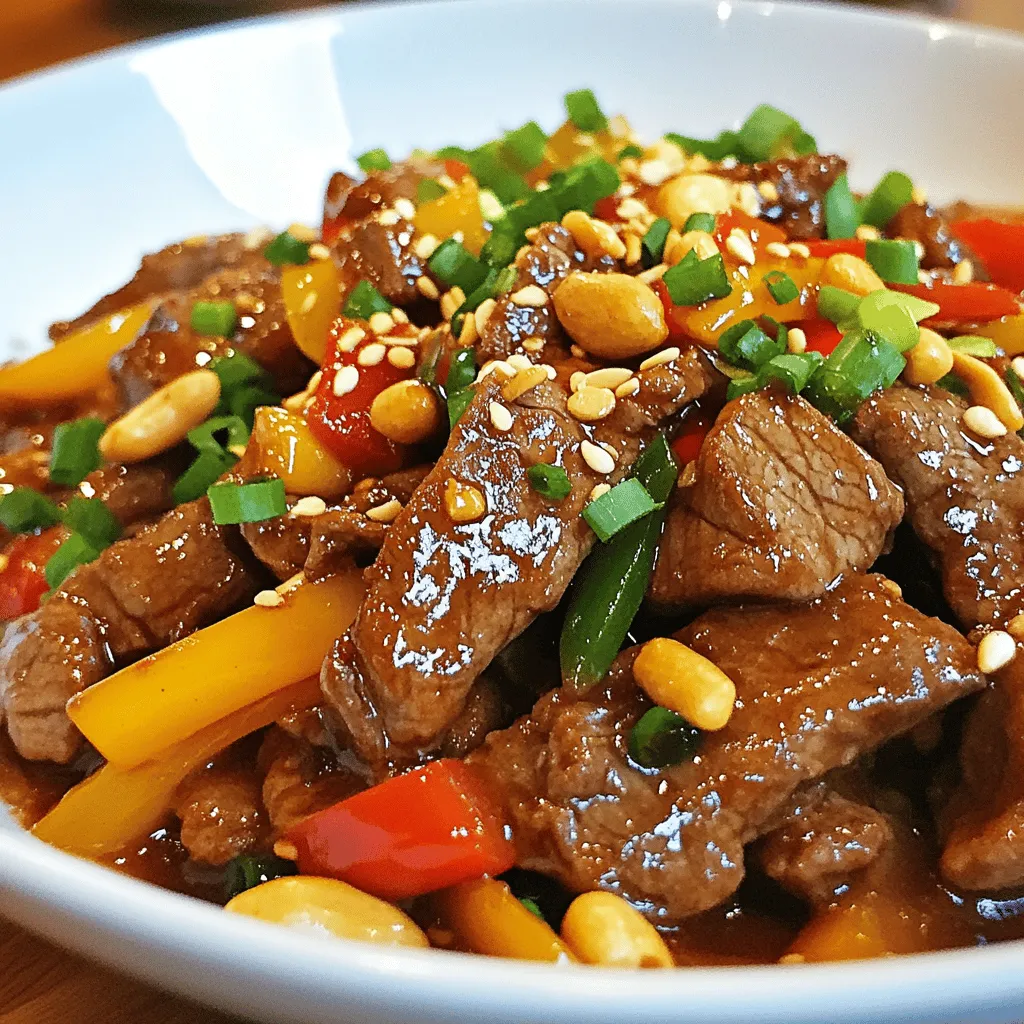
In this recipe, we take Kung Pao Beef to the next level by adding a spicy and crunchy twist. This version not only retains the hallmark flavors of the classic dish but also introduces a delightful crunch that enhances the overall texture. Whether you are a seasoned cook or a first-time chef, making Kung Pao Beef at home is a rewarding endeavor that showcases your culinary skills while allowing you to enjoy a restaurant-quality meal in the comfort of your kitchen.
Homemade dishes like our Spicy & Crunchy Kung Pao Beef are appealing for many reasons. They offer a perfect balance of flavor and texture, allowing you to control the ingredients and adjust the spice level to your preference. Plus, there’s something incredibly satisfying about preparing a meal from scratch that speaks to your taste buds.
Understanding Kung Pao Beef
The origins of Kung Pao Beef can be traced back to the late Qing dynasty in China, where it was originally known as “Gong Bao Ji Ding,” referring to diced chicken cooked in a spicy sauce. The dish was named after Ding Baozhen, a governor of Sichuan province, who was fond of this preparation. Over the years, it has evolved from a simple chicken dish to a beloved staple that varies greatly across different regions, often incorporating various proteins such as chicken, shrimp, or tofu.
Traditionally, the key ingredients that define Kung Pao Beef include marinated beef, peanuts, and a rich, savory sauce made from soy sauce, rice vinegar, and hoisin sauce. The incorporation of Sichuan peppercorns and dried chili peppers ensures that the dish has its signature heat and numbing sensation. However, Kung Pao dishes are not uniform; they change based on local tastes and available ingredients. For instance, in some regions, you might find a sweeter version, while others may emphasize the spiciness.
The flavor profile of Kung Pao Beef is an exquisite blend of salty, sweet, sour, and spicy elements. The juxtaposition of tender beef, crunchy vegetables, and the satisfying crunch of peanuts creates a harmonious dish that is both comforting and stimulating. This balance of flavor and texture is what we aim to achieve in our spicy and crunchy adaptation of the classic recipe.
Ingredients Breakdown
To create the perfect Spicy & Crunchy Kung Pao Beef, it’s essential to understand the role of each ingredient in the recipe. Let’s break down the key components that come together to create this mouthwatering dish.
Beef Sirloin
Starting with the star of the dish, beef sirloin is the ideal cut for Kung Pao Beef due to its tenderness and flavor. It is lean yet has enough marbling to keep the meat juicy when stir-fried. When preparing the beef, it’s crucial to slice it thinly against the grain. This technique not only aids in even cooking but also ensures that each bite is tender and easy to chew. For those seeking alternatives, flank steak or tenderloin can also be used, though they may slightly alter the dish’s texture.
Soy Sauce, Rice Vinegar, and Hoisin Sauce
These three ingredients form the backbone of the marinade and sauce.
- Soy Sauce adds a savory depth and umami flavor that is fundamental to Asian cooking. It enhances the overall taste of the beef while providing a beautiful dark color.
- Rice Vinegar introduces a subtle tanginess that helps balance the richness of the soy sauce and the sweetness of hoisin sauce.
- Hoisin Sauce contributes a sweet and slightly spicy flavor, enriching the sauce and making it more complex. Together, these sauces create a flavorful marinade that infuses the beef with essential flavors.
Vegetables
A colorful array of vegetables not only enhances the visual appeal of the dish but also packs in nutritional benefits.
- Bell Peppers provide a crunchy texture and a mild sweetness that complements the heat from the chili peppers. They are rich in vitamins A and C, making them a healthy addition.
- Garlic is a staple in many cuisines, and its pungent aroma and flavor elevate the dish. It offers numerous health benefits, including anti-inflammatory properties.
Peanuts
The inclusion of peanuts is what gives Kung Pao Beef its characteristic crunch. Toasted peanuts add a nutty flavor and a satisfying crunch that contrasts beautifully with the tender beef and crisp vegetables. They are also a source of healthy fats and protein, making this dish not only delicious but nutritious as well.
Spices
No Kung Pao dish would be complete without its signature spices.
- Chili Peppers are essential for imparting heat. Depending on your spice tolerance, you can adjust the number of dried chili peppers used in the dish.
- Sichuan Peppercorns add a unique numbing spiciness that is synonymous with Sichuan cuisine. They create a tingling sensation that enhances the overall eating experience.
Tips for Selecting High-Quality Ingredients
When preparing Kung Pao Beef, the quality of your ingredients can significantly impact the final dish. Here are some tips for selecting the best components:
- Beef: Look for fresh, bright red beef with minimal browning. It should be firm to the touch, indicating freshness. If possible, buy grass-fed beef for better flavor and quality.
- Vegetables: Choose vibrant, crisp vegetables without any signs of wilting or discoloration. Fresh vegetables not only taste better but also retain more nutrients.
- Sauces: Opt for organic or high-quality soy sauce, rice vinegar, and hoisin sauce. These often contain fewer additives and preservatives, resulting in a cleaner flavor.
- Peanuts: Select raw, unsalted peanuts for the best results. If you can find roasted peanuts, ensure they are not overly salted, as this can overpower the dish’s flavors.
Marinating the Beef
Marination is a crucial step in preparing Spicy & Crunchy Kung Pao Beef, as it enhances the flavor and tenderness of the meat. The process allows the beef to absorb the savory elements from the marinade, resulting in a more flavorful dish.
Importance of Marination
Marinating the beef not only infuses it with flavor but also helps to tenderize the meat. The acids in the marinade, such as rice vinegar, break down the proteins, resulting in a more inviting texture. With proper marination, even less tender cuts can be transformed into a succulent and delicious component of the dish.
Step-by-Step Instructions for Marinating Beef
1. Prepare the Marinade: In a medium-sized bowl, combine soy sauce, rice vinegar, hoisin sauce, minced garlic, and a pinch of sugar. Whisk the ingredients together until well blended.
2. Slice the Beef: Thinly slice the beef sirloin against the grain into bite-sized pieces. This step is essential for maximizing tenderness.
3. Marinate the Beef: Add the sliced beef to the marinade, ensuring that each piece is evenly coated. Cover the bowl with plastic wrap and let it marinate in the refrigerator for at least 30 minutes, but ideally for 1-2 hours. If time allows, marinating overnight will yield even more flavor.
4. Prepare for Stir-Frying: Once marinated, remove the beef from the refrigerator and let it sit at room temperature for about 15 minutes before cooking. This allows for more even cooking.
Suggested Alternatives for Marination
For those with dietary preferences or restrictions, there are alternatives to traditional marination techniques:
- Gluten-Free: Use tamari or coconut aminos as a gluten-free substitute for soy sauce.
- Plant-Based: For a vegetarian or vegan alternative, consider marinating firm tofu or seitan in the same marinade as the beef.
- Spice Level: Adjust the amount of chili peppers or add a splash of sriracha to the marinade for an extra kick.
—
With this detailed introduction to Spicy & Crunchy Kung Pao Beef, you’re well on your way to creating a dish that’s packed with flavor and satisfying crunch. The next steps will guide you through the cooking process, ensuring that you achieve restaurant-quality results in your own kitchen. Stay tuned as we delve into the cooking techniques and tips to perfect this beloved dish!
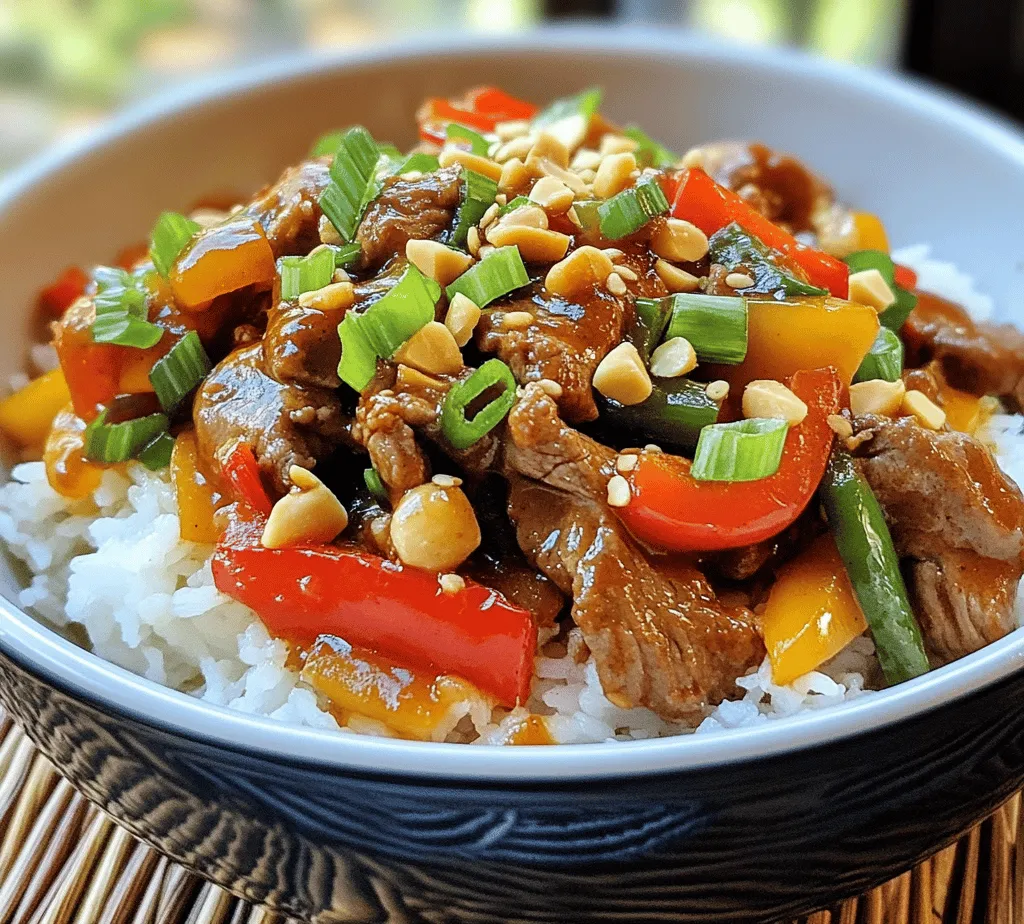
Stir-Frying Techniques
Stir-frying is a quintessential cooking method in Asian cuisine, renowned for its ability to quickly cook food at high temperatures while preserving flavors and nutrients. This technique involves tossing ingredients rapidly in a small amount of oil, resulting in a delightful combination of textures and tastes. To achieve the best results with your Spicy & Crunchy Kung Pao Beef, understanding the intricacies of stir-frying is essential.
Essential Equipment Needed
The right equipment can significantly impact your stir-frying experience. A well-seasoned cast iron skillet or a traditional Chinese wok is ideal for this method. Woks are designed with high sides and a curved shape, allowing you to toss ingredients easily without spilling. They also heat up quickly and uniformly, making them perfect for high-temperature cooking.
If you don’t have a wok, a large, heavy-bottomed skillet can work just as well. Ensure that whatever you use has a non-stick surface or is well-seasoned to prevent sticking and ensure even cooking.
Temperature Control
Temperature control is crucial in stir-frying. Preheat your skillet or wok over medium-high to high heat until hot but not smoking. This temperature allows the beef to sear quickly, locking in juices and flavors. If the heat is too low, the food will steam instead of fry, resulting in a soggy texture. Conversely, if it’s too high, the ingredients may burn before they’re cooked through.
To test if your cooking surface is ready, sprinkle a few drops of water onto it. If they sizzle and evaporate immediately, you’re ready to start cooking.
Visual Cues for Knowing When the Beef and Vegetables Are Cooked
When stir-frying, visual cues are your best indicators of doneness. For the beef, look for a change in color from bright red to a rich brown. The beef should also be tender—overcooked beef will become tough and chewy. For the vegetables, aim for a vibrant color and a slight crunch. They should be tender but still retain some firmness. Bell peppers and green onions should remain bright and crisp, while garlic and ginger should be fragrant and lightly caramelized.
Combining Flavors
The magic of Kung Pao Beef lies in its harmonious balance of flavors: sweet, spicy, and savory. Mastering this balance is key to achieving an authentic taste.
Insights into Balancing Flavors
To create the perfect flavor profile, consider the following components:
- Sweetness: The sugar in the sauce helps to balance the heat from the chili peppers. You can adjust the sweetness by varying the amount of sugar or using a sweet soy sauce.
- Spiciness: If you love heat, feel free to increase the amount of dried chili peppers or incorporate chili paste. However, remember that the spice level can vary significantly based on the type of chili used, so taste as you go.
- Savory Notes: Soy sauce adds depth to the dish. For a richer flavor, consider using dark soy sauce, which contributes both color and umami.
The Role of Peanuts in the Dish
Peanuts play a crucial role in Kung Pao Beef, providing a delightful crunch and nutty flavor that complements the dish’s other elements. When added towards the end of cooking, they retain their texture and provide a satisfying contrast to the tender beef and vegetables. For a twist, you can toast the peanuts briefly in the pan before adding them to the dish, enhancing their flavor and adding an extra layer of crunch.
Importance of Final Seasoning Adjustments
Once your Kung Pao Beef is almost finished cooking, don’t forget to taste and adjust the seasoning. This final step allows you to enhance the dish according to your personal preferences. If you find it too spicy, add a touch more sugar or soy sauce; if it needs more heat, sprinkle in additional chili flakes. The key is to balance the flavors so that none overpower the others.
Serving Suggestions
To truly enjoy your Spicy & Crunchy Kung Pao Beef, consider how to serve it.
Ideal Accompaniments
Kung Pao Beef pairs excellently with steamed white rice, which absorbs the flavorful sauce beautifully. Alternatively, serve it over a bed of noodles for a heartier meal. You could also opt for cauliflower rice for a low-carb option.
Presentation Tips
A visually appealing dish enhances the dining experience. Serve your Kung Pao Beef in a large bowl, garnishing it with freshly chopped green onions or sesame seeds. Adding a side of sliced cucumbers or pickled vegetables can provide a refreshing contrast to the spicy beef.
Dietary Considerations
For those with dietary restrictions, Kung Pao Beef can easily be modified. To make it gluten-free, simply use tamari instead of soy sauce. For a vegetarian version, substitute the beef with tofu or tempeh and follow the same cooking steps. This adaptation maintains the dish’s integrity while catering to various dietary needs.
Nutritional Information
Understanding the nutritional profile of your Kung Pao Beef can help you enjoy it guilt-free. A typical serving (about 1 cup) contains approximately:
- Calories: 300-400
- Protein: 25-30 grams
- Fat: 15-20 grams (depending on the amount of oil and peanuts)
- Carbohydrates: 10-15 grams
Discussion on Health Benefits of Key Ingredients
The key ingredients in Kung Pao Beef offer several health benefits:
- Beef: A good source of high-quality protein, iron, and essential vitamins such as B12.
- Peppers: Rich in vitamins A and C, they boost your immune system and provide antioxidants.
- Peanuts: Packed with healthy fats, protein, and fiber, they can help promote heart health.
- Vegetables: The inclusion of various veggies adds fiber, vitamins, and minerals, enhancing the dish’s overall nutritional value.
Tips for Making the Dish Healthier Without Sacrificing Flavor
You can make Kung Pao Beef healthier by using lean cuts of beef, reducing the amount of oil used, and increasing the proportion of vegetables. Consider adding broccoli, snap peas, or carrots for added nutrition and color.
Conclusion
In conclusion, the Spicy & Crunchy Kung Pao Beef is a delightful dish that merges bold flavors with satisfying textures, making it an ideal quick meal for busy weeknights. Its adaptability allows you to customize it to suit your taste buds, whether you prefer more heat, sweetness, or crunch.
The versatility of Kung Pao Beef extends beyond its traditional boundaries; it can easily be adapted for various dietary preferences while still delivering on flavor.
We encourage you to explore more Asian-inspired recipes that not only diversify your culinary repertoire but also elevate your home-cooking experience. With a little practice and creativity, you can enjoy a delicious array of dishes that bring the vibrant flavors of Asian cuisine right to your kitchen.
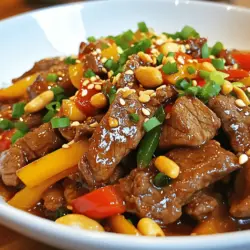

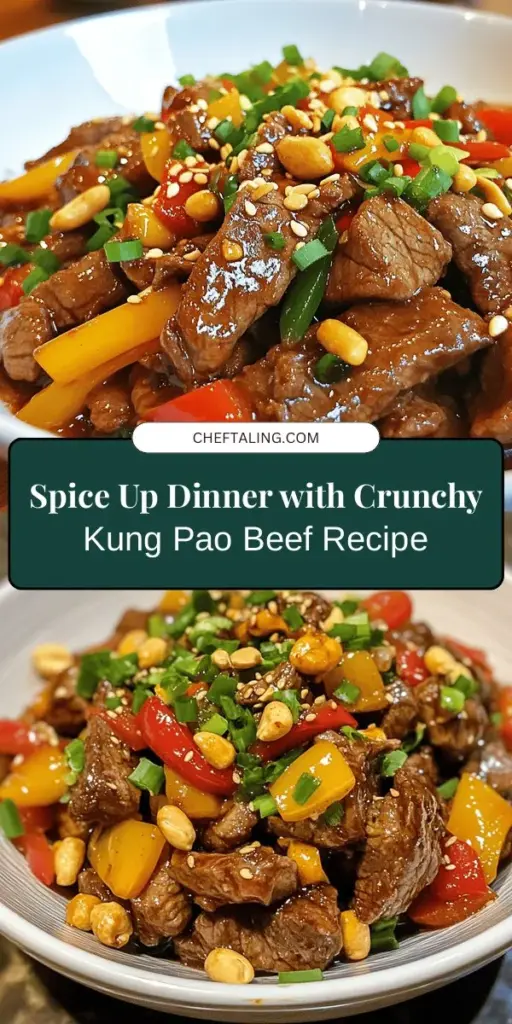

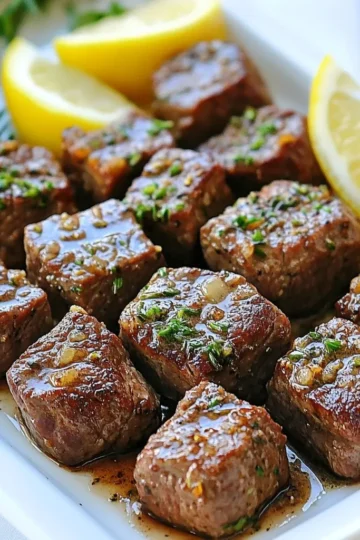
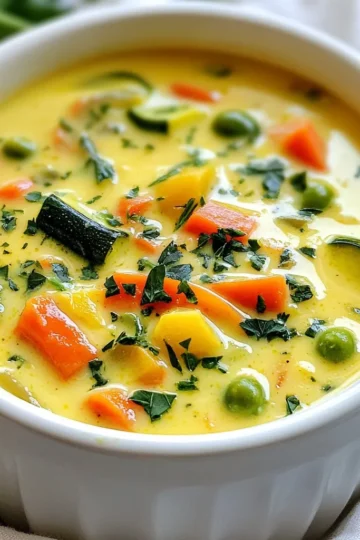
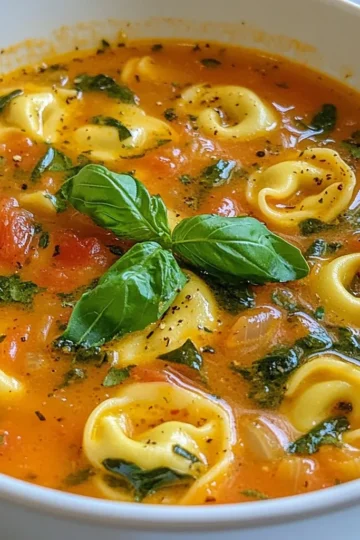
Leave a Reply